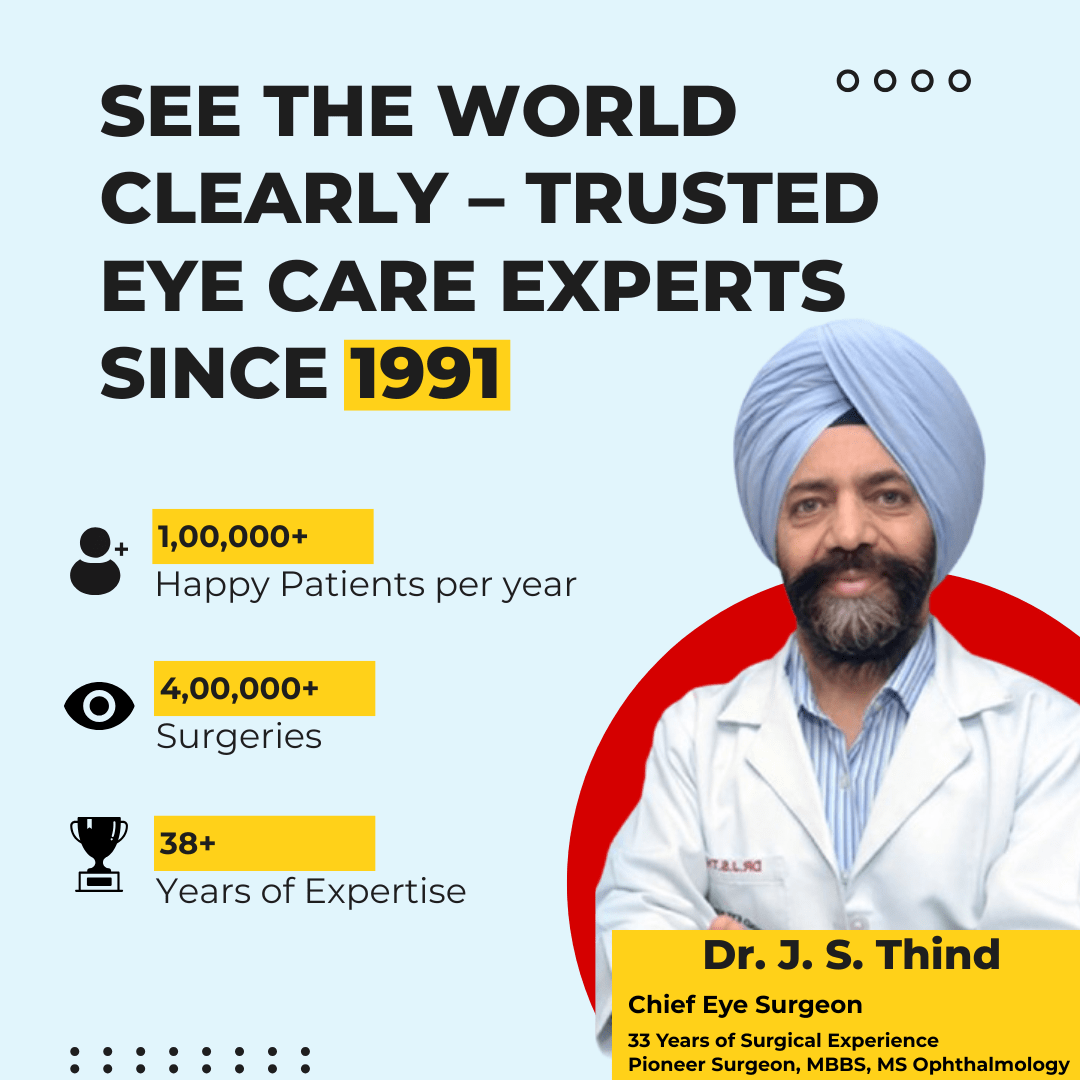Cataracts are one of the most common causes of vision impairment, especially among the elderly. But while cataracts are prevalent, they are also one of the most treatable causes of blindness—when detected early. Knowing the warning signs and seeking timely treatment can prevent irreversible damage and preserve your quality of life.
At Thind Eye Hospital, known as the best eye hospital in Jalandhar, our cataract specialists provide world-class diagnostics, prevention strategies, and surgical solutions tailored to every individual. In this article, we’ll explore the basics of cataracts, how to spot them early, and how you can take proactive steps for cataract prevention and long-term vision restoration treatment.
1. What Are Cataracts and How Do They Affect Your Vision?
A cataract occurs when the natural lens of your eye becomes cloudy, typically due to protein buildup. This clouding gradually blocks or distorts the light that enters your eye, leading to blurred, hazy, or diminished vision.
Cataracts usually develop slowly and are most commonly age-related. However, they can also result from trauma, radiation exposure, or certain medical conditions like diabetes.
The lens of the eye is responsible for focusing light onto the retina. When it becomes clouded, your vision may resemble looking through a frosted or fogged-up window. Without treatment, cataracts can progress to cause significant vision loss and even blindness.
2. Early Signs and Symptoms of Cataracts
Early detection is key to effective cataract prevention and treatment. While cataracts often go unnoticed in their initial stages, the following symptoms may suggest that a cataract is forming:
- Blurry or cloudy vision
- Faded or yellowed colors
- Increased sensitivity to light and glare
- Difficulty seeing at night (night blindness)
- Halos around lights, especially at night
- Frequent changes in glasses or contact lens prescription
- Double vision in a single eye
These symptoms may start subtly and worsen over time. If you’re over the age of 50, it’s important to have regular eye exams—even if you haven’t noticed any problems yet.
3. Preventive Measures and Lifestyle Changes for Cataract Prevention
While cataracts are often associated with aging, certain lifestyle choices can significantly delay their onset or slow progression. Consider the following cataract prevention tips from our senior eye care team:
- Protect Your Eyes from UV Rays: Prolonged exposure to UV rays can accelerate cataract formation. Always wear UV-blocking sunglasses when outdoors—even on cloudy days.
- Quit Smoking: Smoking increases oxidative stress in the eye’s lens, raising your risk of developing cataracts.
- Eat a Vision-Healthy Diet: A diet rich in antioxidants, vitamin C, vitamin E, and omega-3 fatty acids can help support long-term eye health. Foods like leafy greens, carrots, citrus fruits, nuts, and fish should be part of your regular diet.
- Manage Chronic Conditions: Conditions like diabetes and hypertension significantly increase the risk of cataracts. Properly managing your health helps safeguard your vision.
- Reduce Alcohol Consumption: Excessive alcohol intake has been linked to a higher likelihood of cataract development.
- Schedule Regular Eye Exams: Routine check-ups are essential. At Thind Eye Hospital, we use advanced diagnostics to detect early cataract formation even before symptoms are noticeable.
4. Treatment Options: Surgery and Non-Surgical Methods
If cataracts begin to interfere with your quality of life, prompt treatment becomes essential. Let’s explore the available vision restoration treatment options.
a) Non-Surgical Approaches (for early stages):
- Updated Prescription Lenses: For minor clouding, adjusting your eyeglasses may temporarily improve clarity.
- Improved Lighting: Brighter lights can reduce glare and help you see better.
- Lifestyle Adjustments: Avoid driving at night or in low-light conditions if vision is compromised.
While these methods offer temporary relief, cataracts are progressive and won’t go away on their own.
b) Surgical Treatment: The Definitive Solution
Cataract surgery is one of the safest and most effective surgeries performed worldwide. During the procedure:
- The cloudy lens is removed.
- It’s replaced with a clear artificial intraocular lens (IOL).
At Thind Eye Hospital, our experienced cataract surgeons use state-of-the-art technology including femtosecond laser-assisted surgery and premium IOLs to ensure the best possible outcomes.
Benefits of cataract surgery include:
- Dramatic improvement in vision
- Enhanced color perception
- Better night vision
- Reduced dependency on glasses
- Long-lasting results
Whether you require standard cataract removal or advanced options such as multifocal IOLs or toric lenses for astigmatism correction, our team tailors the treatment to meet your needs.
5. Schedule an Appointment with Our Cataract Surgeon for a Consultation
If you’re noticing symptoms of blurred vision, light sensitivity, or difficulty reading and driving, it’s time to speak with a professional. Our highly qualified cataract surgeons and ophthalmologists at Thind Eye Hospital are committed to helping you protect and restore your vision with the latest in cataract diagnostics and treatments.
As the best eye hospital in Jalandhar, we offer:
- Comprehensive senior vision assessments
- Cataract diagnostics using advanced imaging
- Personalized treatment plans
- Pre- and post-operative support
- Access to leading technology and expert care
Take the First Step Toward Clearer Vision
Don’t let cataracts cloud your world. Recognizing the early signs, taking preventive action, and exploring timely treatment options can make all the difference. Whether you’re looking to confirm a diagnosis or discuss vision restoration treatment, our cataract surgeon is here to help.
Schedule your appointment today at Thind Eye Hospital—Jalandhar’s most trusted name in senior eye care and cataract prevention.



